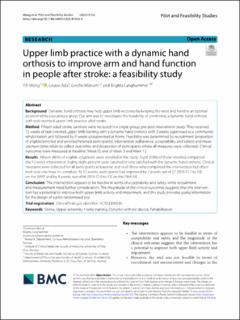| dc.contributor.author | Wong, Yih | |
| dc.contributor.author | Ada, Louise | |
| dc.contributor.author | Månum, Grethe | |
| dc.contributor.author | Langhammer, Birgitta | |
| dc.date.accessioned | 2023-09-07T06:32:08Z | |
| dc.date.available | 2023-09-07T06:32:08Z | |
| dc.date.created | 2023-09-05T13:39:21Z | |
| dc.date.issued | 2023 | |
| dc.identifier.issn | 2055-5784 | |
| dc.identifier.uri | https://hdl.handle.net/11250/3087837 | |
| dc.description.abstract | Background Dynamic hand orthosis may help upper limb recovery by keeping the wrist and hand in an optimal
position while executing a grasp. Our aim was to investigate the feasibility of combining a dynamic hand orthosis
with task-oriented upper limb practice after stroke.
Method Fifteen adult stroke survivors were recruited in a single-group, pre-post intervention study. They received
12 weeks of task-oriented upper limb training with a dynamic hand orthosis with 3 weeks supervised at a community
rehabilitation unit followed by 9 weeks unsupervised at home. Feasibility was determined by recruitment (proportion
of eligible/enrolled and enrolled/retained participants), intervention (adherence, acceptability, and safety) and meas-
urement (time taken to collect outcomes and proportion of participants where all measures were collected). Clinical
outcomes were measured at baseline (Week 0), end of Week 3 and Week 12.
Results Fifteen (46%) of eligible volunteers were enrolled in the study. Eight (53%) of those enrolled completed
the 12-week intervention. Eighty eight percent were satisfied or very satisfied with the dynamic hand orthosis. Clinical
measures were collected for all participants at baseline and in all those who completed the intervention but often
took over one hour to complete. At 12 weeks, participants had improved by 7 points out of 57 (95% CI 2 to 13)
on the ARAT and by 8 points out of 66 (95% CI 0 to 15) on the FMA-UE.
Conclusion The intervention appears to be feasible in terms of acceptability and safety, while recruitment
and measurement need further consideration. The magnitude of the clinical outcomes suggests that the interven-
tion has a potential to improve both upper limb activity and impairment, and this study provides useful information
for the design of a pilot randomized trial. | en_US |
| dc.language.iso | eng | en_US |
| dc.rights | Navngivelse 4.0 Internasjonal | * |
| dc.rights.uri | http://creativecommons.org/licenses/by/4.0/deed.no | * |
| dc.title | Upper limb practice with a dynamic hand orthosis to improve arm and hand function in people after stroke: a feasibility study | en_US |
| dc.type | Peer reviewed | en_US |
| dc.type | Journal article | en_US |
| dc.description.version | publishedVersion | en_US |
| cristin.ispublished | true | |
| cristin.fulltext | original | |
| cristin.qualitycode | 1 | |
| dc.identifier.doi | 10.1186/s40814-023-01353-8 | |
| dc.identifier.cristin | 2172541 | |
| dc.source.journal | BMC Pilot and Feasibility Studies | en_US |
| dc.source.volume | 9 | en_US |
| dc.source.issue | 12 | en_US |

